Discover the Best Board Games for Every Player

Top 7 Fantasy Battle Board Games 2025
Fantasy battle board games have hit new heights in 2025, offering players immersive worlds, tactical depth, and engaging gameplay. Whether you're into large-scale battles, cooperative challenges, or narrative-driven adventures, there's something for everyone. Here's a quick look at the top games this year:
- Burning Banners: Rage of the Witch Queen: A 2–6 player hex-based wargame with six factions, deep strategy, and exploration mechanics. ($79.99–$89.99)
- War of the Ring (Second Edition): A Tolkien-inspired 2–4 player game recreating Middle-earth's epic struggle. ($89.99–$99.99)
- The Elder Scrolls: Betrayal of the Second Era: A 1–4 player RPG-style game set in Tamriel with customizable characters and quests. ($225)
- The Battle of Five Armies: A 2-player game based on The Hobbit, featuring large-scale battles and event-driven gameplay. ($74.99–$84.99)
- Aeon's End: War Eternal: A cooperative deck-building game for 1–4 players, focusing on defending Gravehold from Nemeses. ($59.99–$69.99)
- Fate of the Fellowship: A 2–5 player narrative-driven game set in Middle-earth, featuring iconic heroes and branching storylines. ($64.99–$74.99)
- Wizard Kings: A 2–7 player block-based strategy game with hidden unit strength and modular maps. ($49.99–$59.99)
Each game offers unique mechanics, playstyles, and themes, catering to different preferences. Below, we dive into what makes each game stand out and how to choose the right one for your group.
1. Burning Banners: Rage of the Witch Queen
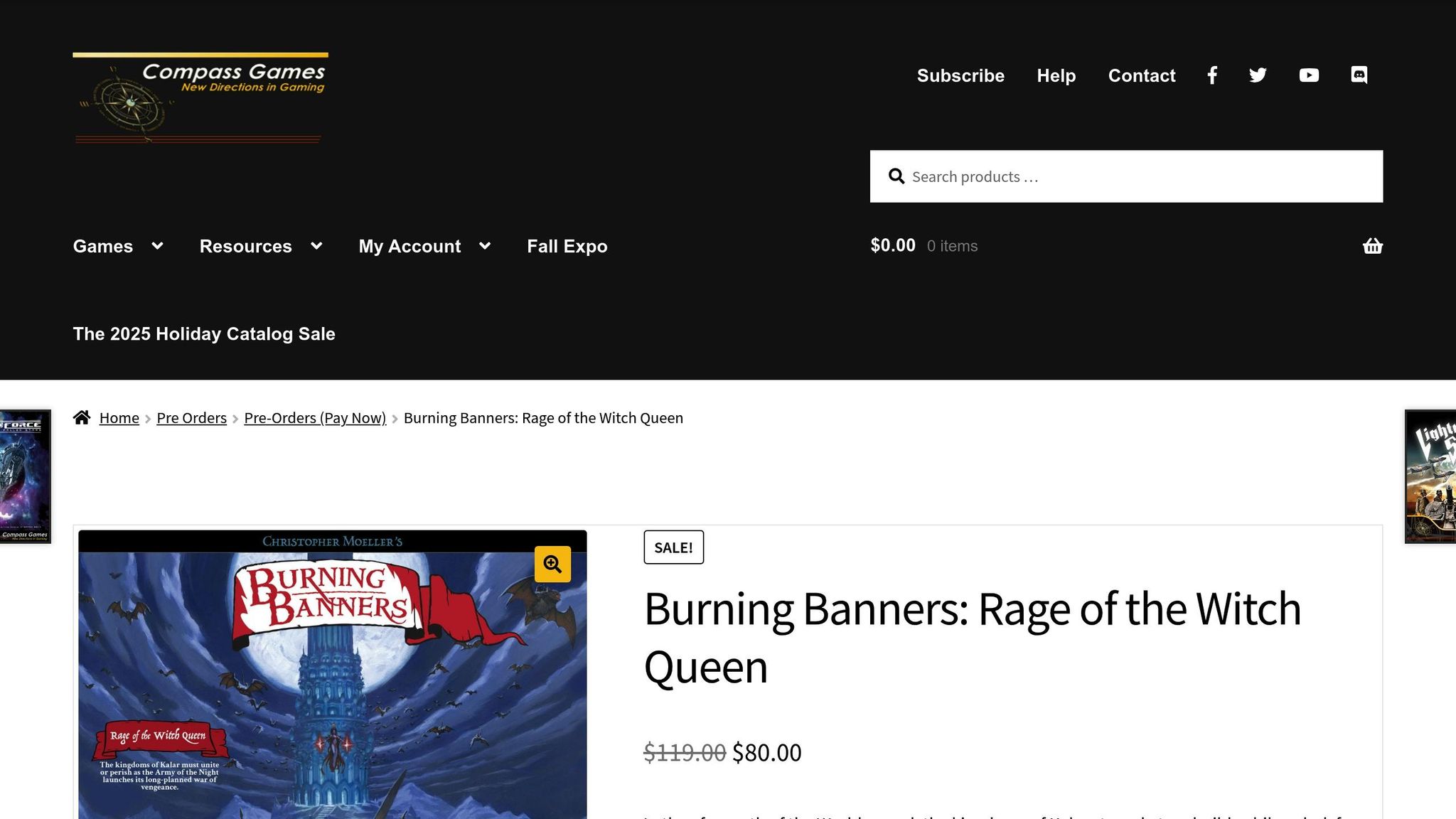
Burning Banners: Rage of the Witch Queen claims the top spot on our list. This hex-based wargame invites 2–6 players into the fantastical realm of Kalar, where six distinct factions battle for dominance. Published by Compass Games, the game masterfully blends traditional army warfare with exploration, ensuring that every session feels fresh and unpredictable. It’s a game that stands out not just for its mechanics but also for its polished design.
Miniature Quality
Rather than using miniatures, Burning Banners relies on counters, but don’t mistake that for a lack of production value. The game’s components are top-notch, featuring stunning artwork by Christopher Moeller, who also played a role in its design. From recessed player boards to beautifully illustrated cards, every element feels thoughtfully crafted, earning high praise from reviewers for its visual appeal.
Battle Scale and Strategy
The game’s strategic depth is where it truly shines. Each of the six factions - like the Orcs, Army of Night, Oathborn (dwarven warriors), and Eastern Empire - offers a completely unique playstyle. For example, the Eastern Empire starts with a stronger economic foundation but faces the constant threat of revolts that can disrupt their resources. Battles take place on a hex-based map, where players vie for control of towns, cities, and monster lairs. This asymmetry demands players adapt their strategies based on the faction they command, making each game a new challenge.
Gameplay Mechanics
What sets Burning Banners apart is its seamless mix of combat and exploration. Beyond clashing with rival armies, players can raid monster lairs scattered across the map to collect gold and uncover treasures. These treasures often provide powerful, single-use abilities that can turn the tide of battle. The game’s asymmetric design ensures that mastering one faction doesn’t translate to success with another, keeping players on their toes and constantly rethinking their tactics.
Replayability
With six asymmetric factions and dynamic in-game events, replayability is one of this game’s strongest assets. Reviewers frequently highlight how no two playthroughs feel the same. Variable monster lairs, faction-specific challenges like revolts, and changes in player count all contribute to this variety. The added layer of treasure hunting and exploration ensures even seasoned players find new strategic opportunities with each session.
For U.S. players, Burning Banners: Rage of the Witch Queen is available at Brain-Games.lv/en/, with pricing in U.S. dollars and shipping options tailored for American customers.
2. War of the Ring (Second Edition)
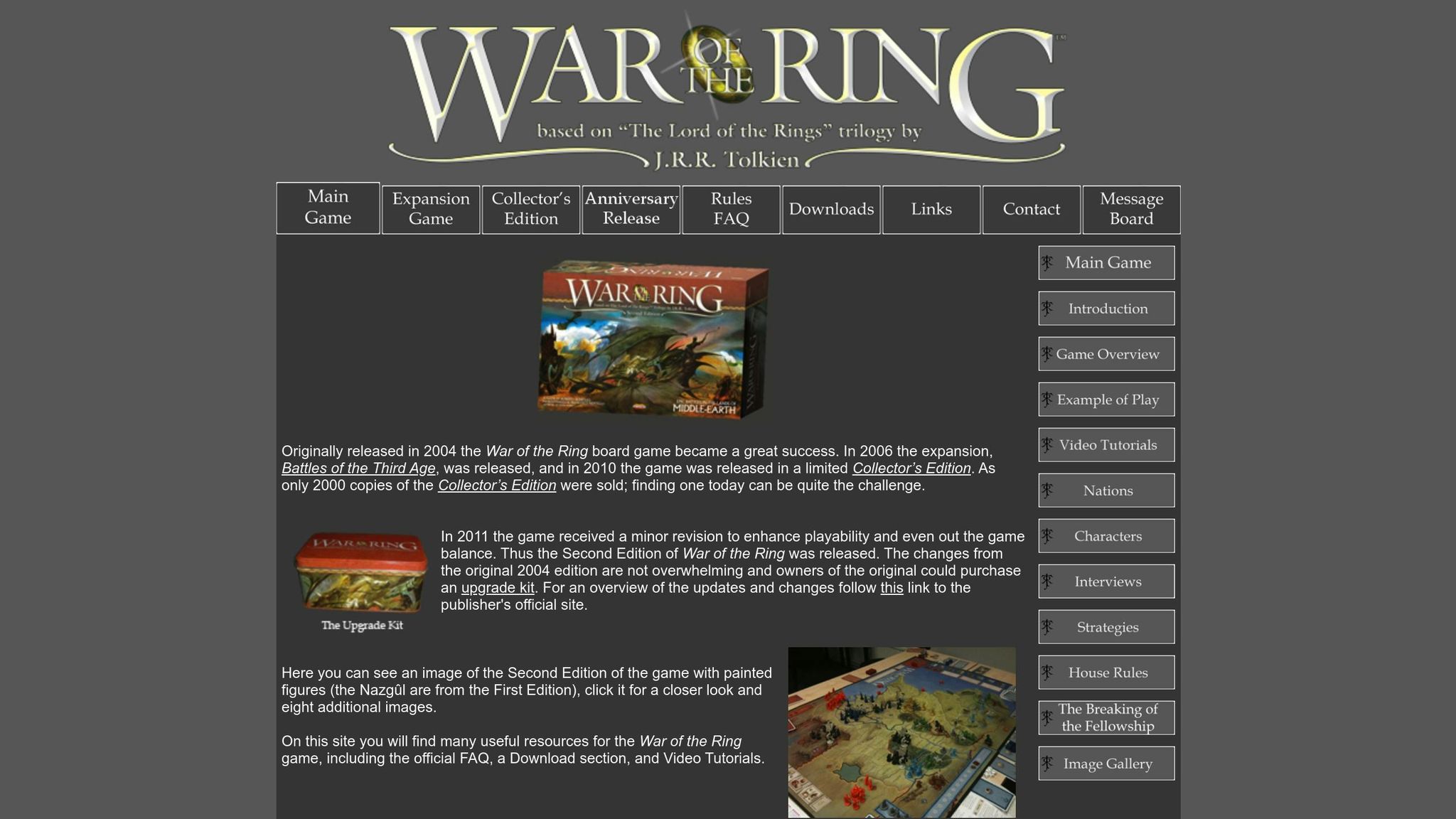
War of the Ring (Second Edition) takes players deep into the heart of Tolkien's Middle-earth, recreating the epic struggle between the Free Peoples and Sauron's Shadow Armies. Designed for 2–4 players, this game transforms the legendary War of the Ring into an unforgettable tabletop experience, combining strategy, storytelling, and immersive gameplay.
Miniature Detail
The miniatures in this edition are beautifully designed, capturing the essence of Tolkien's world. Each faction is brought to life with unique sculpts, from the graceful Elven warriors to the sinister Nazgûl. These detailed figures not only enhance gameplay but also make the game a collector's delight, adding a visual depth that truly brings the battles to life.
Epic Scale and Strategy
War of the Ring (Second Edition) delivers large-scale battles that span the vast regions of Middle-earth. Players juggle commanding armies, deploying heroes, and achieving political objectives. The Free Peoples focus on protecting key quests, like Frodo's perilous journey to Mount Doom, while the Shadow player uses corruption and brute force to dominate. This balance between military strategy and narrative-driven goals creates a level of tension that keeps players deeply engaged.
Core Gameplay Mechanics
At its core, the game uses a combination of action dice and event cards to keep the gameplay dynamic and unpredictable. Players roll dice to move armies, trigger events, or activate characters, while event cards recreate iconic moments from Tolkien's saga. Combat blends tactical positioning with dice rolls, and players must also navigate political tracks and corruption mechanics, adding layers of complexity to every decision.
Endless Replayability
What sets War of the Ring (Second Edition) apart is its replayability. The asymmetric gameplay, variable events, and multiple win conditions ensure no two games are alike. The Free Peoples can triumph through military strength or by destroying the Ring, while the Shadow can achieve victory by spreading corruption or conquering Middle-earth. Each playthrough offers new challenges and strategies, making it equally exciting for first-timers and seasoned players.
For players in the U.S., War of the Ring (Second Edition) can be found at Brain-Games.lv/en/, with prices typically ranging from $50–$100 and convenient shipping options available.
3. The Elder Scrolls: Betrayal of the Second Era
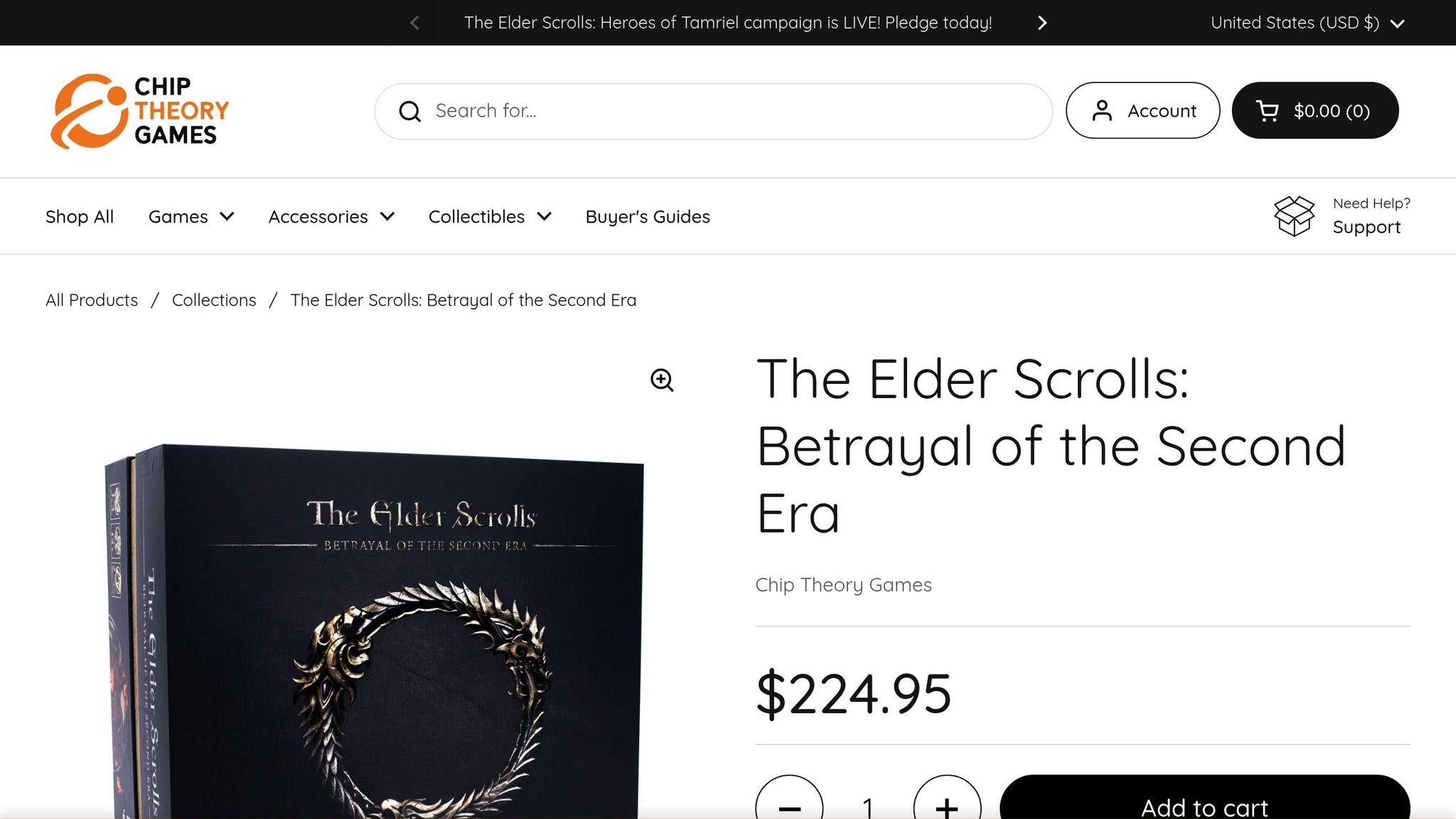
The Elder Scrolls: Betrayal of the Second Era brings the rich world of Tamriel from the beloved Elder Scrolls series to your tabletop. Published by Chip Theory Games in 2025, this board game captures the universe's signature mix of political drama, epic battles, and deep exploration. Players will journey through six unique regions and navigate the shifting alliances of nine distinct guilds.
Gameplay Mechanics
This game masterfully combines adventure, tactical combat, and narrative-driven quests. Players take on missions from various guilds, which can lead to anything from intense battles and dungeon crawls to intricate political schemes. What makes this game stand out is its deep customization system. You can pick any race and class combination and develop your character with the skills of your choice, closely mirroring the freedom of progression seen in the video game series.
Throughout the game, you’ll find combat, exploration, and diplomacy seamlessly woven together. Every encounter not only shapes the overarching story of Tamriel but also forces players to consider faction dynamics, resource management, and character growth. These elements create a rich, decision-driven experience.
Battle Scale and Strategy
Conflicts in the game range from small, tactical skirmishes to massive, region-shaping battles. The strategic depth comes from balancing immediate combat decisions with long-term campaign goals. Whether you lean into military conquest or prefer subtle political strategies, the guild system introduces unique missions and rewards that can shift alliances and alter the game's power dynamics.
Replayability
Replayability is a core feature of The Elder Scrolls: Betrayal of the Second Era. With nine guilds and six expansive regions, no two playthroughs feel the same. Each session presents a fresh narrative and strategic puzzle to unravel. As noted by Board Game Quest, this title is "easily my favorite game of 2025 thus far."
Designed for 1–4 players, sessions typically last between 120 and 240 minutes, providing a deep and rewarding experience for solo players and groups alike. Priced at $225, this game offers a premium adventure for those who love immersive fantasy gaming.
For U.S. players eager to explore Tamriel in a whole new way, The Elder Scrolls: Betrayal of the Second Era is available at Brain-Games.lv/en/.
4. The Battle of Five Armies
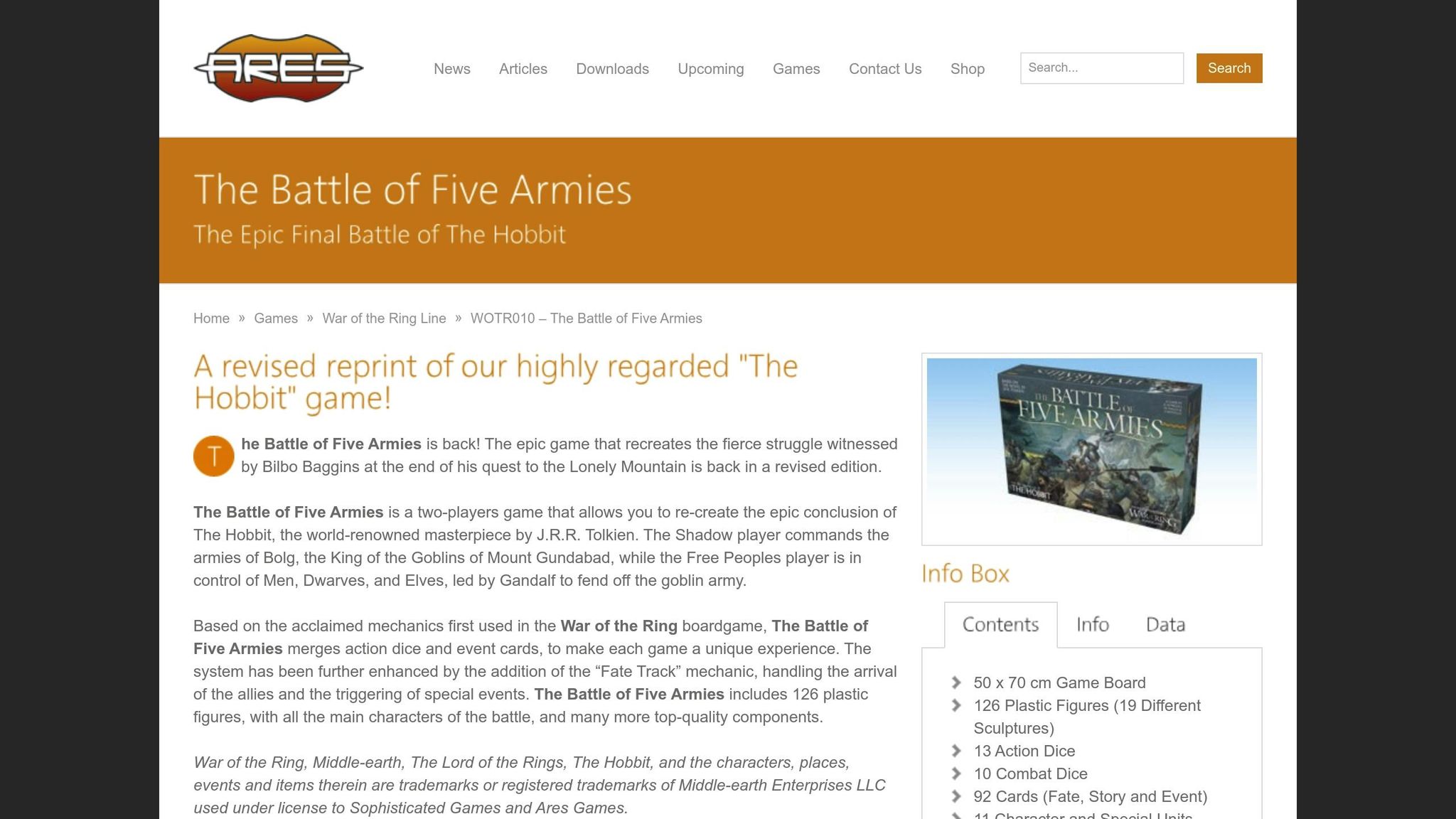
The Battle of Five Armies brings to life the legendary conflict from Tolkien's The Hobbit, set at the base of the Lonely Mountain. Players take command of the armies of elves, dwarves, men, goblins, and wargs, all striving for dominance on the battlefield. Staying true to Tolkien's narrative, the game uses a modified version of the popular "War of the Ring" system, combining strategic depth with the rich themes of Middle-earth. While it builds upon familiar mechanics from earlier games, it also introduces fresh tactical challenges to keep players on their toes.
Miniature Design
The miniatures in this game are nothing short of impressive. Each army is brought to life with carefully crafted figures, from elven archers and dwarven warriors to the swarming goblin hordes. Unique sculpts for heroes and commanders add character, while larger figures like eagles and trolls stand out as striking visual elements on the battlefield.
Gameplay Features
The gameplay blends area control, dice-driven combat, and event cards to create a dynamic and immersive experience. Special mechanics, like fate points and unique actions, add layers of strategy, allowing players to turn the tide of battle at crucial moments. With asymmetric objectives, each side faces its own set of challenges: the Free Peoples must defend their positions, while the Shadow Armies aim for complete conquest. Event cards not only provide tactical advantages but also weave narrative moments into the gameplay, keeping the story alive.
Strategy and Scale
Commanding entire armies, players must navigate a balance of large-scale strategy and immediate tactical decisions. Whether it's maneuvering formations, timing reinforcements, or securing key locations, every choice matters. The game rewards players for balancing bold offensives with calculated defenses, creating high-stakes moments where committing elite units - or holding them back - can determine the outcome.
Replay Value
With its dynamic event decks and asymmetric gameplay, The Battle of Five Armies offers a fresh experience every time you play. The contrast between the objectives of the Free Peoples and the Shadow Armies ensures no two battles feel the same, keeping the tension and excitement alive.
Designed for two players, this game strikes a fine balance between being accessible and offering deep strategic gameplay. U.S. players can dive into this epic Tolkien-inspired battle by visiting Brain-Games.lv/en/, where it’s part of a diverse board game collection.
5. Aeon's End: War Eternal
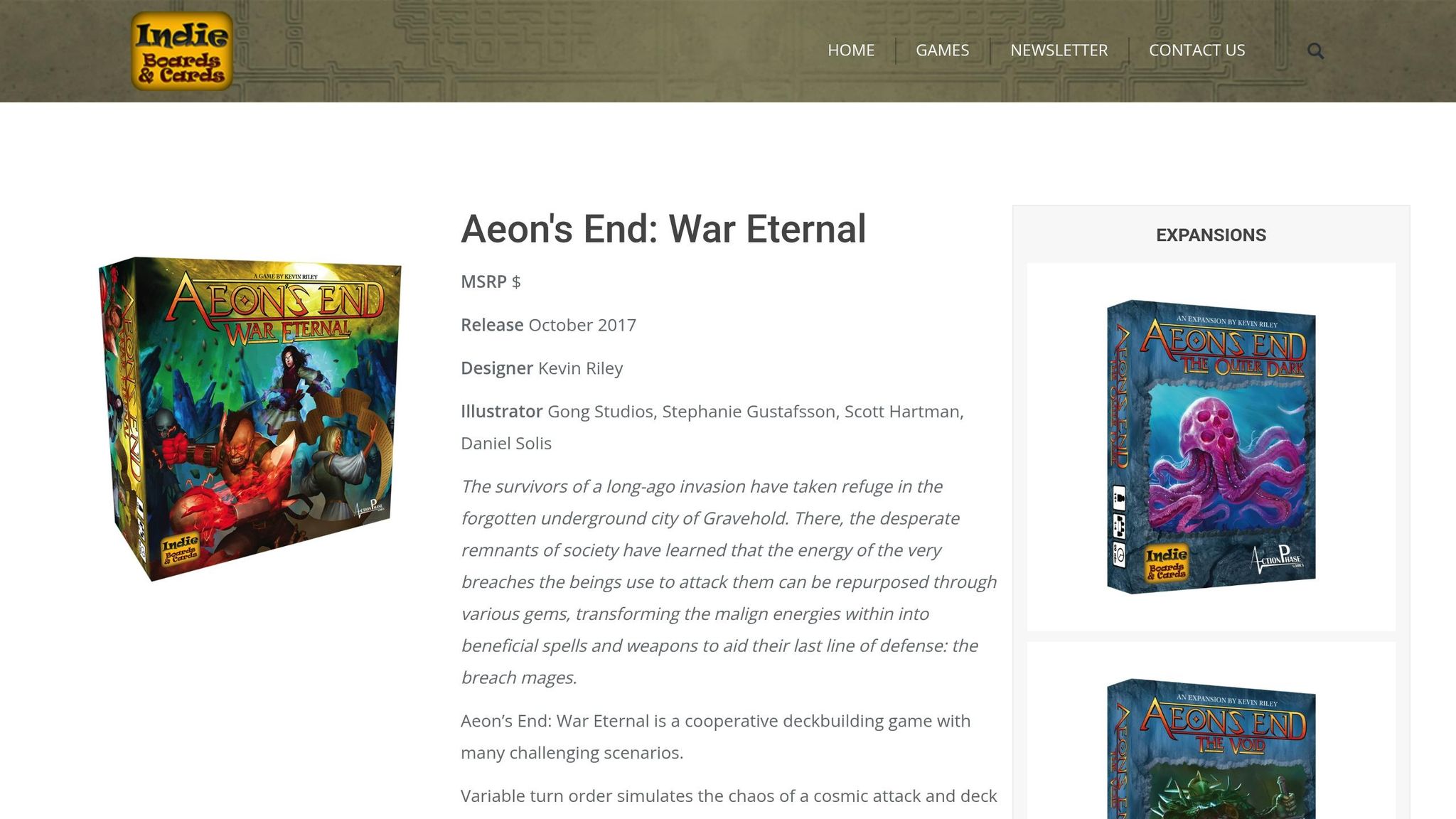
Aeon's End: War Eternal shifts away from traditional miniature battles, offering a cooperative deck-building experience instead. In this game, players take on the roles of mages defending Gravehold from relentless Nemeses. Success hinges on teamwork and careful planning, making each session a test of strategy and coordination.
Gameplay Mechanics
The heart of War Eternal lies in its unique deck-building mechanics. Unlike most games, there’s no shuffling - discarded cards are placed at the bottom of your deck in the order they’re played. This twist rewards players who can think several steps ahead. Adding to the unpredictability, a variable turn order ensures no two rounds feel the same. Each mage comes with their own abilities and starting cards, encouraging diverse strategies and roles within the team.
One standout feature is the spell-casting system. Spells must be prepared in advance and can only be cast on a later turn. This adds layers of strategy, as timing becomes just as important as the spells themselves. Together, these mechanics create a deeply tactical experience where every decision matters.
Battle Scale and Strategy
Rather than focusing on massive armies, War Eternal zeroes in on smaller, tactical encounters. Each Nemesis presents a unique challenge, forcing players to adjust their strategies on the fly. Teamwork is essential - players must decide who will take on offensive roles, who will handle defense, and who will manage resources to keep Gravehold safe. The city’s health is critical, and losing it means defeat.
The game’s card market is another layer of strategy. Players must balance investing in powerful, long-term cards with grabbing cheaper, immediate solutions to address current threats. This dynamic market ensures that players are constantly adapting, turning setbacks into opportunities with effective communication and quick thinking.
Replayability
One of the game’s greatest strengths is how it stays fresh over time. Its modular design and ever-changing card market make each session feel unique. Whether playing solo or with up to four players, the game scales beautifully to suit different group sizes. Solo players can enjoy a challenging puzzle, while full teams can dive into intricate, cooperative strategies.
For those who want more, War Eternal is part of a broader series with expansions like Aeon’s End: Legacy and The New Age, offering endless new challenges and content. With sessions lasting around 60–90 minutes, it’s a perfect choice for game nights. If you’re in the U.S. and ready to defend Gravehold, you can find this cooperative gem at Brain-Games.lv/en/, alongside a wide selection of other strategic board games.
sbb-itb-1ed942f
6. Fate of the Fellowship (Lord of the Rings)
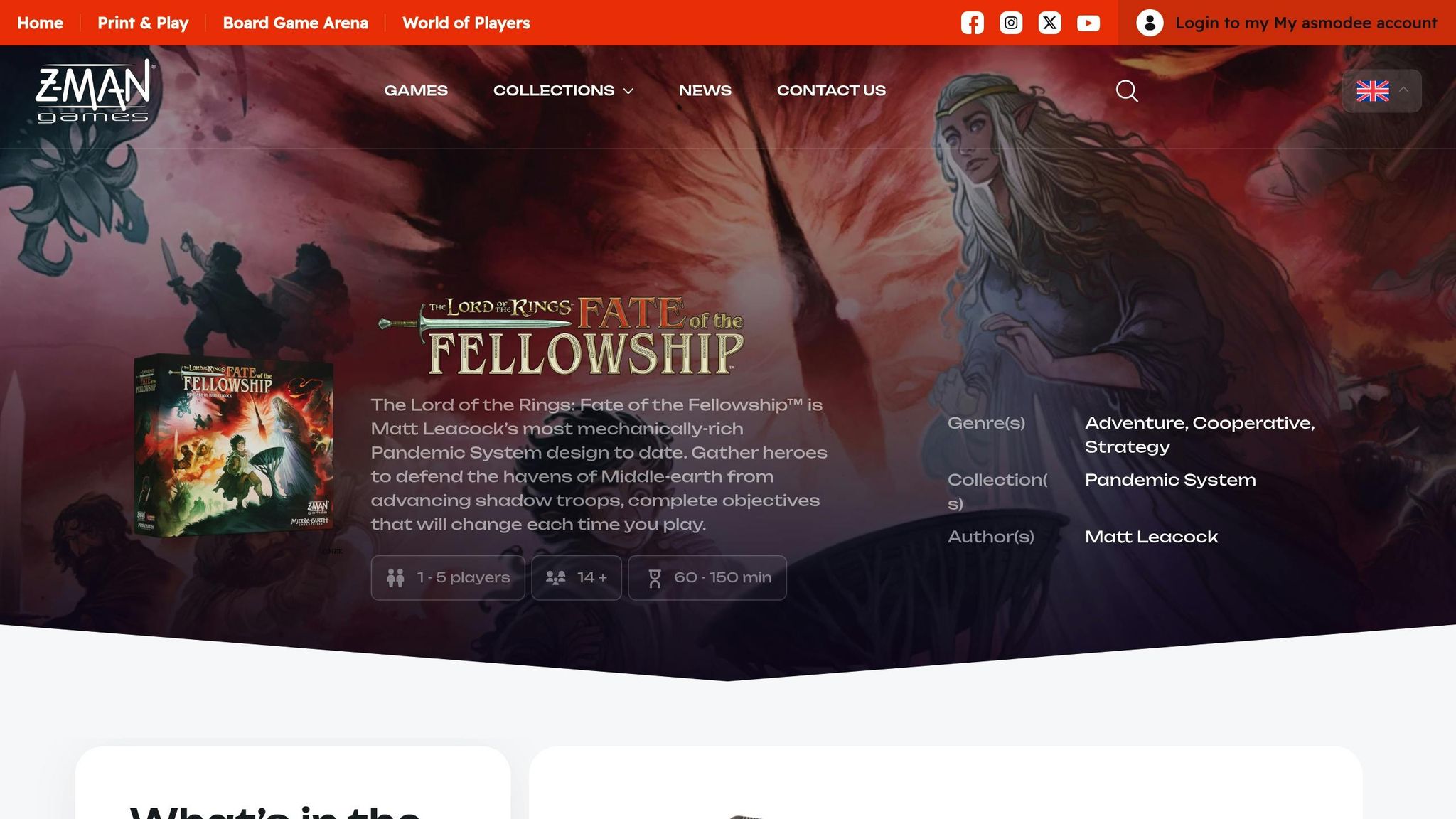
Fate of the Fellowship brings Middle-earth to life with narrative scenarios and character-driven objectives inspired by Tolkien's epic tale. Players take command of iconic heroes and their allies, engaging in battles that feel fresh and distinct from other Lord of the Rings-themed games. From its detailed miniatures to its immersive gameplay, this title offers a truly engaging experience.
Miniature Quality
The miniatures in this game are a feast for the eyes. Iconic characters like Aragorn, Legolas, and Gandalf are brought to life with intricate detailing and dynamic poses. Even the enemy figures have unique designs that elevate the visual experience. To top it off, the textured bases - designed to reflect Middle-earth’s diverse landscapes - add a touch of authenticity to every piece.
Gameplay Mechanics
At its core, the game revolves around action point management and card-driven events. Players must carefully balance their resources, plan coordinated moves, and make use of each character’s unique abilities. The game’s scenario-based objectives and narrative choices add depth, making every decision feel like a crucial part of the unfolding story.
Battle Scale and Strategy
Combat in Fate of the Fellowship ranges from small skirmishes to large-scale battles, capturing the variety of conflicts seen in Tolkien’s work. One standout scenario is the defense of Helm’s Deep, where players must guide the Fellowship and their allies through wave after wave of enemy attacks. With dynamic wall breaches, special hero abilities, and ever-changing victory conditions, this scenario perfectly blends dramatic storytelling with tactical gameplay.
Replayability
The game shines when it comes to replayability. Modular scenarios, branching storylines, and randomized enemy setups ensure that each playthrough feels fresh. Sessions typically last between 90 to 180 minutes and accommodate 2–5 players, making it adaptable to different group sizes and schedules. Plus, planned expansions promise to introduce new scenarios, characters, and miniatures based on key moments from the Lord of the Rings trilogy, offering even more strategic possibilities.
For those in the U.S. eager to dive into this Middle-earth adventure, you can find Fate of the Fellowship at Brain-Games.lv/en/.
7. Wizard Kings

Wizard Kings, designed by Tom Dalgliesh and published by Columbia Games, brings a fresh twist to fantasy warfare. Instead of traditional miniatures, the game uses a wooden block system that cleverly hides unit strength behind a fog-of-war mechanic. This adds an element of strategic bluffing, as players command entire fantasy armies across modular hex-based maps. While you can see your opponent's block positions, the real strength of their units remains a mystery, making every move a calculated risk.
Gameplay Mechanics
At the heart of Wizard Kings is its unique block-based system. Each wooden block represents a battalion, with its strength concealed from opponents. Players move their forces across a modular map and engage in battles resolved with dice rolls influenced by terrain and unit types. The game accommodates 2–7 players, with sessions typically running 60 to 120 minutes. It strikes a great balance between strategic depth and accessible gameplay, making it engaging without feeling overwhelming.
Battle Scale and Strategy
The scale of Wizard Kings is impressive, with each block symbolizing an entire battalion rather than individual characters. The modular hex-tile system creates endless battlefield layouts, from narrow mountain passes to sprawling open plains. This variety forces players to think carefully about army composition, positioning, and timing. The hidden strength mechanic adds another layer of depth, allowing for strategic bluffing that keeps opponents guessing. With seven distinct armies - Orcs, Undead, Elves, Dwarves, Amazons, Barbarians, and Men - each offering unique strengths and tactics, every battle feels fresh and unpredictable.
Replayability
Replayability is one of Wizard Kings' standout features. The modular map tiles allow players to create a new battlefield for every session, and the base game includes seven diverse armies to experiment with. Expansion sets, priced between $29.99 and $39.99, add even more variety by introducing additional armies, terrain tiles, and scenarios. The active community on BoardGameGeek also contributes custom scenarios, ensuring the game stays fresh for years to come.
For players in the U.S. eager to lead their own fantasy armies, Wizard Kings is available at Brain-Games.lv/en/, with pricing in dollars and shipping options tailored for American buyers.
Game Comparison Chart
When it comes to picking the perfect fantasy battle board game, a lot depends on your group's vibe, how much time you can spare, and the level of complexity you're after. To make things easier, here's a chart that breaks down the essentials of each game. It’s followed by a quick summary to help you spot the key differences at a glance.
| Game | Players | Playtime | Battle Scale | Key Mechanics | Miniature Quality | Price Range |
|---|---|---|---|---|---|---|
| Burning Banners: Rage of the Witch Queen | 2–4 | 90–120 min | Army vs Army | Area control, dice combat | High-quality plastic | $79.99–$89.99 |
| War of the Ring (Second Edition) | 2–4 | 150–180 min | Epic campaign | Card-driven, dice pools | Detailed plastic figures | $89.99–$99.99 |
| The Elder Scrolls: Betrayal of the Second Era | 1–4 | 60–90 min | Skirmish battles | Modular scenarios, RPG elements | Premium miniatures | $69.99–$79.99 |
| The Battle of Five Armies | 2 | 120–150 min | Massive warfare | Asymmetric gameplay, event cards | High-detail figures | $74.99–$84.99 |
| Aeon's End: War Eternal | 1–4 | 45–75 min | Cooperative defense | Deck-building, spell casting | Standees (no miniatures) | $59.99–$69.99 |
| Fate of the Fellowship | 1–5 | 60–90 min | Story-driven battles | Narrative scenarios, character progression | Plastic miniatures | $64.99–$74.99 |
| Wizard Kings | 2–7 | 60–120 min | Battalion warfare | Hidden strength blocks, modular maps | Wooden blocks | $49.99–$59.99 |
Some games are perfect for quick sessions, like Aeon's End: War Eternal, which wraps up in 45–75 minutes. Others, like War of the Ring, offer deep, immersive campaigns that can stretch to 3 hours. The number of players also varies widely, from the intimate 2-player battles in The Battle of Five Armies to the larger 7-player skirmishes in Wizard Kings.
The scale of battles ranges from small, RPG-inspired skirmishes in The Elder Scrolls: Betrayal of the Second Era to massive, sweeping campaigns like War of the Ring. And when it comes to components, there’s something for everyone - from the polished plastic miniatures in Burning Banners to the classic wooden blocks of Wizard Kings. Whether you're after a quick game night or an epic, hours-long adventure, this guide helps you find the perfect match for your group's style.
How to Choose the Right Game
Selecting the perfect fantasy battle board game boils down to your group's preferences and play style. Think about factors like complexity, playtime, rules depth, and how much interaction your group enjoys. These considerations, along with the game comparison chart above, can help you make the right choice.
For casual players or newcomers, opt for games with straightforward rules and shorter sessions. A great example is Aeon's End: War Eternal, which offers cooperative gameplay that's easy to pick up but still engaging.
If your group thrives on strategy and tactical challenges, look at games like Burning Banners: Rage of the Witch Queen. It features intricate economic systems and six distinct factions, each with unique abilities. This variety ensures seasoned players can experiment with fresh strategies every time they play.
Thematic depth is also key for groups that love storytelling and immersive worlds. The Elder Scrolls: Betrayal of the Second Era stands out for its rich narrative and highly customizable gameplay. This level of detail not only draws players into the story but also keeps each session feeling fresh and replayable.
Group size and available time are practical factors to consider. For example, The Elder Scrolls: Betrayal of the Second Era works well for 1–4 players and runs about 2–4 hours, making it perfect for dedicated game nights. On the other hand, Burning Banners: Rage of the Witch Queen accommodates up to six players, while games like Wizard Kings offer flexible player counts, making them ideal for larger gatherings.
Before committing to a game, take a look at the rules and tutorials. Clear instructions, online playthroughs, and community feedback can give you a sense of whether a game’s complexity fits your group’s comfort level.
For a curated selection of titles, check out Brain Games’ online store. They offer both their own award-winning games and popular international options, making it easy to find something your group will love.
FAQs
What should I consider when picking the best fantasy battle board game for my group?
When picking out a fantasy battle board game, there are a few things to keep in mind to make sure it’s a hit with your group. Start with the group size - some games are perfect for just two players, while others are better suited for larger gatherings.
Next, think about the complexity level. Does your group thrive on intricate strategies and detailed rules, or do they lean toward games that are quick to learn and play?
The theme and setting are also important. Would your group get excited about epic showdowns featuring mystical creatures, or do they prefer a more grounded, classic fantasy vibe? Lastly, take a look at the game's components - things like miniatures, board design, and other elements. High-quality pieces can make the game feel more immersive and enjoyable.
What are the key differences in gameplay between 'Burning Banners: Rage of the Witch Queen' and 'War of the Ring (Second Edition)'?
Both games bring fantasy battles to life, but their gameplay styles and mechanics cater to different tastes. Burning Banners: Rage of the Witch Queen focuses on fast-paced tactical combat, offering customizable armies and dynamic scenarios. It's a great choice if you enjoy quick thinking and strategic variety. Meanwhile, War of the Ring (Second Edition) dives deep into Tolkien's world, combining area control with asymmetric gameplay. One player leads the Free Peoples, while the other commands Sauron's forces, creating an experience steeped in lore and grand strategy.
If you love epic, story-driven battles, War of the Ring captures that essence beautifully. For players who thrive on adaptability and diverse tactics, Burning Banners provides a thrilling and flexible challenge.
Why is 'The Elder Scrolls: Betrayal of the Second Era' a great choice for fans of story-driven board games?
We couldn’t locate detailed information about The Elder Scrolls: Betrayal of the Second Era or its gameplay mechanics. This makes it tricky to dive into what might set it apart for fans of narrative-heavy board games. If you're interested in exploring similar story-rich experiences, check out our selection of immersive board games that deliver captivating tales and engaging gameplay!






